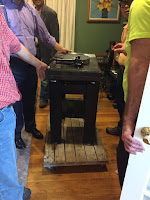
 L. Finally Got It Up! R: Reward for the Stooges.
L. Finally Got It Up! R: Reward for the Stooges.
How Many Stooges Does it Take to Move a Table? Keeping Up with Audio Handymen and Gluttons
Letter From NYC (69) 2017 (8): Making Rounds in Metropolitan NY
The BIG and BAD Preamp Shootout: Jadis JPS2, Audio Research SP-11 Mk II + Mk I Modified, Conrad Johnson Premier 3 AND Harman Kardon Citation I!!
Review, Harman Kardon Citation I, Part II
Audition: TIEN Direct-Drive Turntable
Talk Vinyl: The Western Electric Phenomenon
!Addendum (10/28/17): Citation I, Part III (more action against other preamps) has been published.
This article chronicles two long days with the audio gang. The activities far outstripped my ability to write them up (
and I still have
my own long-delayed agenda). I am still TIRED! I say,
Far From the Madding Crowd!
Part I. The Garden State Troopers
Two weeks ago, R and Andy picked me up in the morning, and drove to New Jersey, where we were joined by James (from Philadelphia, but a frequent presence in NYC) and friends.

 Click pics to enlarge. R: Workshop Front; L: Interior, system was VPI TT, modified CJ PV-5, VAS amps, JBL 4343. Note too the B&W 801 and R's Watt/Puppy 5.1. On the walls were covers of many re-issue LP's. More pics at bottom of article.
Click pics to enlarge. R: Workshop Front; L: Interior, system was VPI TT, modified CJ PV-5, VAS amps, JBL 4343. Note too the B&W 801 and R's Watt/Puppy 5.1. On the walls were covers of many re-issue LP's. More pics at bottom of article.
Collector, DIY, Manufacturer, all in one
First stop was Stephen's workshop, right next to VPI, where R's pair of Watt/Puppy were unloaded to be refurbished.
Stephen, an unassuming fellow, is an enthusiastic audio collector of both hardware and software (LP's and even R2R tapes!) He is also an industry professional who represents VAS, Cayin and Aurum Cantus. We spotted but did not get to hear a VAS Citation I replica. The workshop also does OEM jobs for others. Technically savvy and with a DIY bend, Stephen also does skillful restoration and mods for his friends. After hanging around a bit, Stephen generously treated us to a delicious lunch at his favorite Chinese restaurant. Then we headed to the next stop.
 Click pic to enlarge. Simple but VERY effective system.
Click pic to enlarge. Simple but VERY effective system.
I know what you want, and I know what I want
Leo is a vinyl collector and reseller. Basically, he spends a lot of time foraging for LPs, and is apparently well known to many vinyl sellers in the NY metropolitan area. He resells quite a bit of it to the largest vinyl store in Taiwan. The
very large basement has boxes of vinyl piled up and strewn all over, and what you see in this pic is just tip of the iceberg.
The man has thoroughly studied various audiophile vinyl buying guides (there are many in Chinese) and knows the price of every audiophile record. Unusual among audiophiles, he himself has a preference for Columbia LPs, and there are tons of them strewn around. As R wanted to buy some classical records, Andy (and I) picked some out for him while listening to the excellent horn system, which deserves a little more coverage.
The horns are Altec A5, the crossover made by Canadian Chinese magazine writer and audio guru "Spring" Yeung (
彈弓楊). Preamp is CJ Premier 3, driving Jadis SE300B monoblocks. Most interesting, however, was the turntable:
 Click pic to enlarge.
Click pic to enlarge.
Tien Direct-Drive Turntable was the first brainchild of Taiwanese vinyl and analogue dealer Mr. Tien of Tien Audio (
田昌政類比音響)(
Official Blog), with industrial design by D.More (
也作設計). It was very well received in Taiwan and has found distributors in several Asian countries and France. It won Taiwan's Golden Pin Design Award (
here, with English description of the rationale behind the award).
For those who read Chinese, there is good coverage of its genesis in an article in Taiwan's
AV magazine 高傳真視聽. Those who don't should still peruse this link for all the pics, which include various prototypes. A short description: The plinth is made of birch. The direct drive motor is obviously directly below the acrylic platter, mounted on a PCB board for control electronics. The motor is fastened by four screws with rubber washers providing some measure of isolation. Note the platter retainer (small rubber ring) around the spindle (visible in the main pic of the official blog) providing additional shock absorbance. It comes with a modified Rega arm (some bearings replaced by gem stones, exactly what not mentioned). Note also the other arm shown in the article is a more expensive version, with the front portion of the Rega arm lengthened and replaced by a carbon tube.
:format(jpeg):mode_rgb():quality(40)/discogs-images/R-3270464-1323264923.jpeg.jpg)
Tien has since gone on to design more higher end models, including a 3-motor Voyd-like design, but imho none looks as good as his original namesake. The Tien sells for Taiwan Dollar 38,000 (roughly USD 1250) which, judging from its looks and what I heard (below), is GREAT value, and deserves wider distribution. Despite that, supposedly demand so far has outstripped supply due to manufacturing bottleneck.
Leo used to use "better" cartridges but apparently he has broken a few. Fed up, he switched to the humble Shure V15MkII. In this large room, the performance of the cheap analogue setup in the system was just marvelous, and almost everyone thought it sounded better than their previous visits.
It had all the presence that Altec is famous for, largely without the attending raggedness. St James Infirmary (one of many original copies Leo owns; jealous?) growls and grimly grinds along as it should. Led Zep's
Stairway to Heaven was full-throttled. Most miraculously, classical playback was also very good as evidenced by 2 versions of
Night on Bald Mountain: LSO/Solti (Decca) was dark and menacing; my dark horse favorite, Boston Pops/Fiedler (DG) was a frenzied whiplash.
I personally think the large room and plenty of absorbance (all those boxes) contributed greatly to the good sound. This ranks as one of the very best Altec systems I have heard.
 Click to enlarge. Note the added rectifier (5AR4), choke and additional heatsinks.
Click to enlarge. Note the added rectifier (5AR4), choke and additional heatsinks.
Part II, Long Island Reunion - The Longest Day
Last Sunday, the augmented Audio Handymen (Andy, Simon, James, Stephen and wife, Mark and I) descended on R's mansion (equipment and previous visit detailed
here). Even though R already possesses the
Jadis JPS2, Citation I and CJ Premier 3, he was curious about the
ARC SP-11. So James brought in from Philadelphia his stock SP-11 MkII. Stephen also came with his modified tube-rectified SP-11 MkI (which he prefers to MkII) which we saw earlier in NJ.
As usual, R put us to work before lunch, and this time it was a BIG task, moving the
Rockport Sirius II into the living room. The thing is definitely over 300 lb. One could do some desoldering to separate the parts but it was too much of a hassle. So four of us held the corners and lifted it up while two quickly shoved the dolly under. Unfortunately the dolly could not clear the rear legs and we could not lift it up higher, so an extra person came to the rescue in the back and finally it was done. Unloading was much easier. The Rockport actually looked very nice in the LR but we did not get to hear it as there were no air pump and vacuum yet in the living room (hole on the floor would have to be drilled for the tubings to come from the basement motor unit). Now, that was the physically taxing part of the program.
We picked out some music to listen to and for using later. For some reason (perhaps cabling)
the system sounded a little coarser than last visit. After a few sides we adjourned for lunch.
The Ideal Audiophile Wife Stephen's wife Jenny is no audiophile, but obviously she has seen and heard more than most people. She totally supports her husband in his ventures (as with many men, more than just audio) and actually conversed with us on audio. Ode to the lady!
Lunch this time was perfectly turned (a given for R) Hanger Steak garnished with Cauliflower and Brussel Sprouts, washed down with some Californian wine. Again, unlike audio, just perfect. Then some of us had the Durian that Andy bought (see pic at bottom; wiki entry
here). Most Americans probably have never had this tropical Asian fruit, as it has a strong smell and an intricate taste. The one Andy picked (and he took a
long time; I was waiting in the car) was a great one, with an intense yet complex taste. Like with certain cheeses, I still am not a fan, but I can appreciate it. Afterwards, strong coffee was mandatory and the barista (lady of the house) made a great expresso.
After lunch the mentally taxing part, the preamp shootout, began in earnest.

- ARC SP-11 MkII James' is stock, tubed with mostly Russian tubes. I should mention here that I have always been a fan of older ARC's. In HK, I still have an SP-3, SP-8MkII, SP-10MkI and SP-11MkII, so am familiar with the sound of this hybrid preamp. It was just as I remembered it. The sound had great presence, fast transient speed and a tight, walking bass, but the midrange was not quite as rich as an all-tube preamp. Compared to the Jadis JPS we heard before lunch, on Saxophone Colossus, Rollins' sax was missing a little bowel sound, and Max Roach's drumsticks were not quite woody when slapped together or on the drum edges. However, the rhythmic snap and timing were superior, the Jadis a bit heavy footed in comparison. Mahler's Second (VPO/Mehta, London) also could have used a bit more heft, but it was atmospheric and uplifting. Again, the Jadis was richer, but a bit brutal during fortissimi. I then wanted to try Stephen's MkI power supply on this unit, but a loud hum told us it was not compatible.

- SP-11 MkI (Tube Rectified) Compared with the stock SP-11 MkII, the tube rectified and choke filtered MkI was definitely smoother, with less high frequency hash (not that there was a lot before). The midrange was a little richer, but still not quite like an all-tube unit. The gain in fullness and smoothness in both Saxophone Colossus and Mahler Second was met with approval by most of the crowd, but I thought this came at the price of rhythmic vitality and transient speed, a trade I personally would not want to make. I actually think one can hear the FET part of the hybrid, and in my opinion it is not a trait that can be camouflaged in its entirety (in many ways, among hybrid preamps, the very good Counterpoint thousand series does better in this regard, the best in my experience being the Melos 222, though it is a little dark sounding.)
- ARC SP-11 MkII Redux This time James put in more vintage tubes (I don't know what), and sound sweetened a little. However, the re-tubed unit lacked a little definition in comparison and, like the effect of tube rectification, also lost some rhythmic vitality and transient speed. I myself preferred the first iteration.
- Tom Tutay Phonoamp At this point, R's Tom Tutay phonoamp was swapped in in lieu of the SP-11's own phono section. A word on Tom Tutay: he apparently is a well regarded DIY person who runs Transition Audio Design (no website). The one R has is actually an early all-tube full function preamp, though R is only using the phono section, which looks very much like the later Tutay phonoamp named Vibrance, which employs both octal and noval tubes. We have heard it in conjunction with the Linn many times before. The sound was definitely a little darker, smoother and warmer than ARC's own phono section. As with designs employing the larger octal tubes, images were larger and fleshier. though a trifle homogenized (as Andy put it). I thought it had sounded better with the Jadis JPS in R's regular rig during the last visit. This synergy thing is unpredictable and has upset many an audio boat! One more thing on this phono design. The octal tubes are prone to microphonics and noise. R's unit works with the Cardas cable, which rolls of the top, but with my considerably more neutral Gotham GAC-2, R reported hearing high frequency noise, likely tube noise, but that shall be investigated.
- Conrad Johnson Premier 3 R had used its phono section in his previous room before he dismantled it; in contrast, Andy has long been using the similar Premier 2 (tube rectified) as a linestage (preferring the Citation I's phono section). As a full preamp, it put in a performance that was the most puzzling and inconsistent of the lot. It was the warmest and most full-bodied of the lot and was easy to listen to, but in comparison with the others it seemed sluggish and lacking in sparkle and resolution. I wondered if it was out-of-phase but was told that this is one of the rare CJ preamps that is not phase-inverting. From my experience, old CJ is too much of a good thing - big caps likely slow down the sound and make it more earthbound. Used as a full preamp, the problem compounds itself; no wonder both of my friends use only a half of it. The CJ, especially the phono section, is definitely not neutral. This experience also reinforces my view that these slower and darker components work with horns better than with conventional speakers (even the modernist Citation I usually works better with horns than regular stuff; that it works so well with this system and Wilson surprised me a little.)
- Harman Kardon Citation I Once again, this vintage classic, beloved by me, Andy and others (see Part I), instantly revealed its true mettle. The sound was modernist in tendency and well balanced, very neutral and with excellent resolution, reasonable transient speed and clean bass. Add a good dose of presence and touch of tube warmth and it was quite wonderful. Most approved, and Mark exclaimed that he wanted one. R made the decision to have the Citation stay in the system and he took the Jadis JPS out, that is how much he liked it. But, was it perfect? No, there was just a trace of leaness and coarseness that increased with volume. To me, in a way, it was like the SP-11 with more tube and less FET characteristic, though the Citation I's power supply is by no means comparable, commonly faulted for being marginal for support of the large number of tubes. Nonetheless, a classic. Note that I spoke to R later and he said he found it a little fatiguing after prolonged listening, but I am sure that can be ameliorated by some cable matching; I am sure you will hear more of this later.
- My Choice Personally, I'd prefer to work around the more neutral Citation I or stock ARC SP-11. The colored CJ is clearly not my cup of tea, but has its adherents. The equally colored Jadis JPS strangely was ousted in this session, but it should have done better (as last time).
Collector vs Glutton Call it what you want, but there is only a thin divide between the collector and the glutton. However, somewhat unfairly, the former has an elevated aura and the latter is usually a denigration. More than the Glutton, the Collector could morph into a Connoisseur, though most don't. Most of the time, we are all of these rolled into one. This certainly applies to Andy, James, Stephen and I, even R! Talking about myself, I hoard both equipment and software. I have over 10,000 LP's and thousands of CDs - there is no way I can listen to each one even once. There is also tremendous duplication. Simon and Leo have not much extraneous equipment, and hence are not audio gluttons, but they collect LPs prized by audiophiles. Leo of course is a reseller; maybe that's the best way, buy what you like, yet have an easy way to unload stuff. In HK, this is why
many audiophiles ultimately end up in business (physical and virtual shops) - one would have to when one has amassed way too much and reached critical mass. But then when money comes into it, things get complicated, even with friends - something to think about.
Vinyl Talk: The Western Electric Phenomenon There is a dark side to the US's unparalleled history of innovation, invention and progress - waste. There is another dark side to the US's inborn revolutionary and evolutionary attitude - undervaluation of heritage. Both of these play a very significant role in the current state of audio, particularly vintage audio. I'll expound on this in detail n another article. Here we will only note that nobody much in the US buys classical music LPs, but there are many people like Leo, from especially from HK, China and Korea, who buy these and ship them back to Asia, because they are treasured by audiophiles there. Like the depletion of 300B and other WE tubes and equipment in the US, classical vinyl (the better titles and selected pop titles) is heading the same way.
More photos. From top: Durian (does it not look like a mis-proportioned organ?); Note the VAS Citation I between 2 vertical stacks of VPI 16.5; Tip of the iceberg, note the Quicksilver, McIntosh 240 and Marantz 8B; No eggs, but much more expensive VPI tonearms.
:format(jpeg):mode_rgb():quality(40)/discogs-images/R-4327776-1453764402-2413.jpeg.jpg) Thank You Happiness is also giving thanks. NYC Here I'd like to thank Andy for organizing all these events which provided a modicum of relief for me during a period when I saw mother through considerable strife. I'd also like to thank teetotaler Kevin for serving us expensive Napa wines and driving me to the airport. Also to Ralph and Andy again for cooking those wonderful meals. HK I'd like to thank my friend wss in particular for helping me get rid of some unused goodies languishing in my old home, for hosting happy hour at his small den, and for the free concert tickets. Readers Thank you readers for your words of encouragement - I appreciate them.
Thank You Happiness is also giving thanks. NYC Here I'd like to thank Andy for organizing all these events which provided a modicum of relief for me during a period when I saw mother through considerable strife. I'd also like to thank teetotaler Kevin for serving us expensive Napa wines and driving me to the airport. Also to Ralph and Andy again for cooking those wonderful meals. HK I'd like to thank my friend wss in particular for helping me get rid of some unused goodies languishing in my old home, for hosting happy hour at his small den, and for the free concert tickets. Readers Thank you readers for your words of encouragement - I appreciate them.

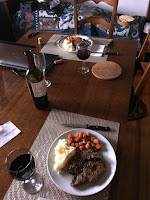
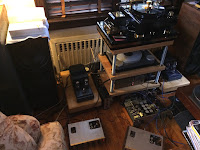

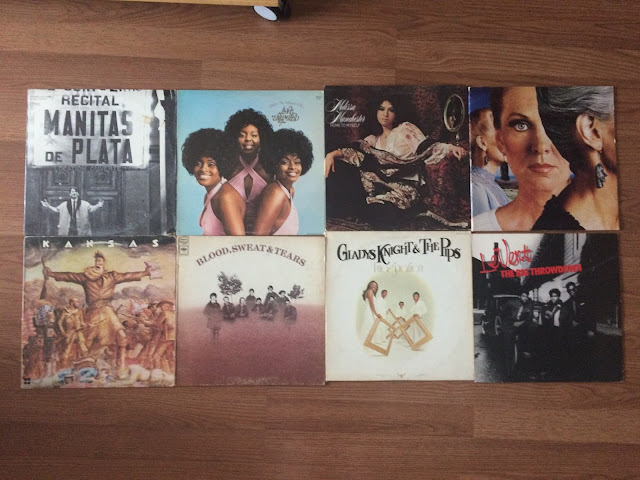
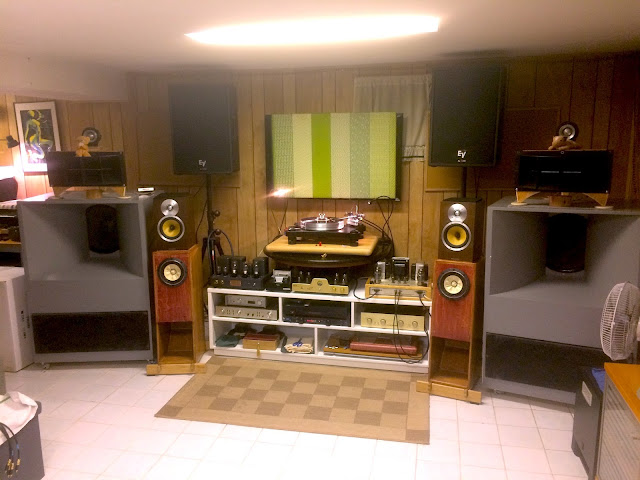



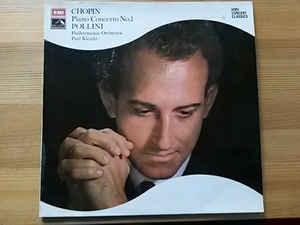





:format(jpeg):mode_rgb():quality(40)/discogs-images/R-3270464-1323264923.jpeg.jpg)





















